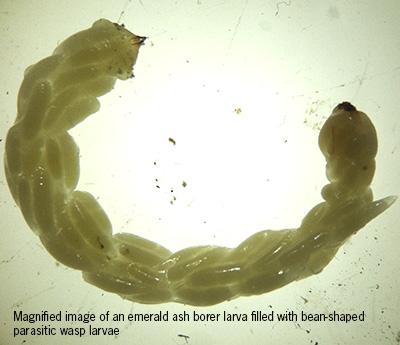Assessing the Impact of Emerald Ash Borer Biological Control on the Health of Ash Trees in Two Outlier Infestations in New York State

Emerald ash borers (EAB) are invasive exotic beetles inadvertently introduced into the eastern United States where they have spread, caused mortality of ash trees, and now threaten ash in the Northern Forest region. NSRC researchers quantified EAB populations and released parasitoids (parasitic wasps being tested as a biological control for EAB) in two EAB-infested areas of New York State. Researchers monitored establishment of EAB parasitoids, quantified if they will significantly affect EAB populations, and evaluated short and long-term impacts of EAB biological control on ash health.
Parasitoids were released at eight study sites in 2011, 2012, and 2013. Since 2013, university and New York State and federal agency researchers have collaborated to deploy and monitor yellow pan traps to gauge parasitoid establishment. They quantified within-tree densities of EAB and parasitism rates of EAB larvae and eggs by felling and peeling bark of ash trees.
By annually monitoring ash health, researchers documented the state of both large and small trees in relation to biological control releases. Although numbers of dead and dying trees have increased over time, parasitism of EAB is also increasing over time, and there is a much higher parasitism rate of EAB in ash saplings than in larger ash trees. Seedling and sapling inventories indicate there will be another cohort of ash, so with establishment of parasitoids, there is hope they will exert control of EAB populations. A follow up study in 2020 and every five years thereafter would be beneficial for continued monitoring of the efficacy of biological control.
